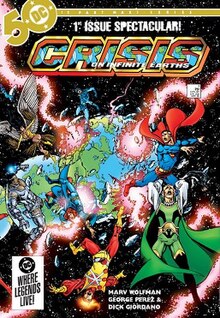
Back Crisis on Infinite Earths Catalan Crisis on Infinite Earths German Crisis on Infinite Earths Spanish Crisis on Infinite Earths French המשבר בעולמות האינסופיים HE Crisis on Infinite Earths Hungarian Crisi sulle Terre infinite Italian クライシス・オン・インフィニット・アース Japanese 크라이시스 온 인피닛 어스 Korean Crisis on Infinite Earths Dutch
| Crisis on Infinite Earths | |
|---|---|
 Cover of Crisis on Infinite Earths #1 (April 1985). Art by George Pérez. | |
| Publication information | |
| Publisher | DC Comics |
| Schedule | Monthly |
| Format | Limited series |
| Publication date | April 1985 – March 1986 |
| No. of issues | 12 |
| Main character(s) | |
| Creative team | |
| Created by |
|
| Written by | Marv Wolfman |
| Penciller(s) | George Pérez |
| Inker(s) | |
| Letterer(s) | John Costanza |
| Colorist(s) |
|
| Editor(s) | Marv Wolfman |
Crisis on Infinite Earths is a 1985 to 1986 American comic book crossover series published by DC Comics. Written by Marv Wolfman and pencilled by George Pérez, it was first released as a 12-issue limited series from April 1985 to March 1986. As the main piece of a crossover event, some plot elements were featured in tie-in issues of other publications. Since its initial publication, the series has been reprinted in various formats and editions.
The idea for the series stemmed from Wolfman's desire to abandon the DC Multiverse depicted in the company's comics—which he thought was unfriendly to readers—and create a single, unified DC Universe (DCU). The foundation of Crisis on Infinite Earths developed through a character called the Monitor, introduced in Wolfman's The New Teen Titans in July 1982 before the series itself started.
At the start of Crisis on Infinite Earths, the Anti-Monitor (the Monitor's evil counterpart) is unleashed on the DC Multiverse and begins to destroy the various Earths that it comprises. The Monitor tries to recruit heroes from around the Multiverse but is murdered, while Brainiac collaborates with the villains to conquer the remaining Earths. Eventually, both the heroes and villains are united by the Spectre; the series concludes with Kal-L, Superboy-Prime and Alexander Luthor Jr. defeating the Anti-Monitor and the creation of a single Earth in place of the Multiverse. Crisis on Infinite Earths is noted for its high death count; hundreds of characters died, including DC icons Kara Zor-El (the original Supergirl) and Barry Allen (the Flash of the Silver Age). The story's events resulted in the entire DCU being rebooted, dividing the fictional universe's timeline into "pre-Crisis" and "post-Crisis" eras.
The series was a bestseller for DC. The story is credited with popularizing the idea of a large-scale crossover in comics. Crisis on Infinite Earths is the first installment in what became known as the Crisis trilogy. It was followed by Infinite Crisis (2005–2006) and Final Crisis (2008–2009). Dark Crisis on Infinite Earths (2022) also served as a sequel to Crisis on Infinite Earths.